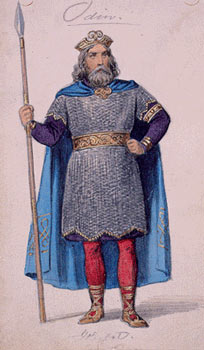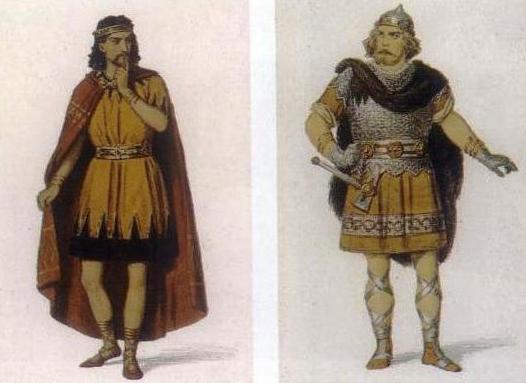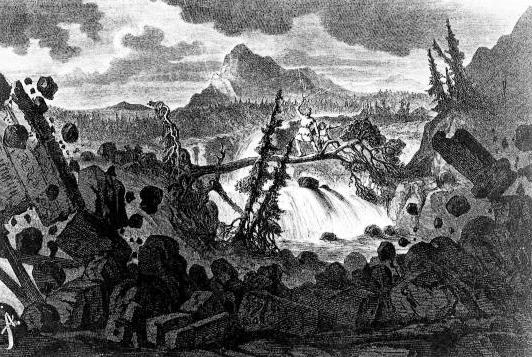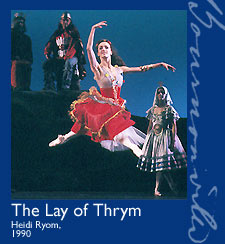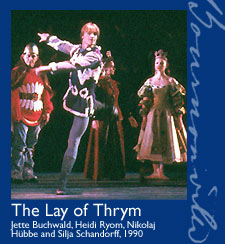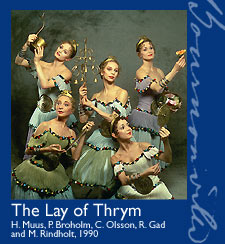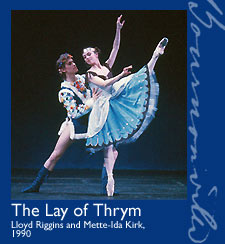Artistic Director of
The Royal Danish Ballet
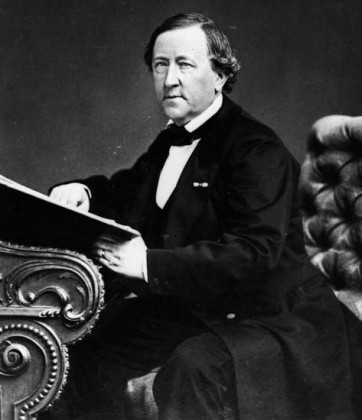
[HOME][POPULAR RETELLINGS]
|
August Bournonville (1805-1879), ballet master and principal choreographer who led the Royal Danish Ballet for nearly half-a-century and created more than fifty singular and enchanting Romantic-era ballets. A personal friend of Hans Christian Andersen, the first half of Bournonville’s career falls firmly within the Danish Golden Age. The choreographer carried many of its ideals into the second half of the nineteenth century, serenely ignoring the shift in the zeitgeist towards realism, which inevitably spelled the death of Romanticism. His father, Antoine Bournonville (1760-1843) came from a French family which produced several actors. Born in Lyon, August later joined with Georges Noverre (1727-1810), the great reformer of dance in Vienna. After having worked for a while in Stockholm, he settled in Copenhagen in 1792 at the Royal Theater. Attracted to ballet early, his first training came from the Danish Royal Theater under the tutelage of Italian Vincenzo Galeotti. His first contract with the Royal Theater Ballet as a student was signed in 1811. In 1816, he succeeded Vincenzo Galeotti (1733-1816) as ballet master, a position he would hold for over 40 years, attesting to his great talent. Galeotti had served as ballet master and principal choreographer of the Danish Royal Ballet from 1775 to 1816. Bournonville’s life in the theater also was exceptionally long and productive. Late in his career, he dabbled in Nordic themes in the years prior to the debut of Richard Wagner's Ring Cycle in 1876. |
|||||||||||||
|
Thrymskviden / The Lay of Thrym
Thrymskviden. a ballet in 4 acts, published 1891. Johan Peter Emilius Hartmann, 1805-1900, composed a great deal of stage music, in which the Nordic ballets Valkyrien (1861, The Valkyrie) and Thrymskviden (1868, The Lay of Thrym) occupy a central position. Hartmann's chamber music, especially his piano music, is remarkable, and in his day he was highly respected for his cantatas and songs. As an administrator in the Music Association and a teacher in the Academy of Music in Copenhagen he exercised a decisive influence on Danish musical life in the second half of the nineteenth century. J.P.E. Hartmann worked with the choreographer August Bournonville (1805-79) on several occasions, resulting in such works as Et folkesagn (A Folk Tale; 1854), the highly successful Valkyrien (1861), and Thrymskviden, op. 67 (The Legend of Thrym; 1868). Bournonville was then sixty-five. Argueably their finest collaboration, Valkyrien is based on the ancient Saga of the Shieldings from Saxo Grammaticus's 13th century history of Denmark. Remarkable pieces among Hartmann's rousing score include the Valkyrie dance and Valhalla March from Act I, the delicate temple music for flute, harp and violin in Act III, and the Bravalla Heath Battle sequence from Act IV. Vilhelm Christian Holm performed the bridal dance from The Lay of Thrym (1868). The role of Thor in Thrymskviden added to both his stature and his popularity, and he was very much the hero of the 1871 ballet. While Valkyrien and his other works are well known in Denmark, Hartmann did not achieve international fame. August Bournonville's 1858 fantasy "Abdallah" resurfaced in 1985 in Salt Lake City, and his 1868 mythological epic "The Lay of Thrym" re-premiered in Copenhagen in May of 1990. In Copenhagen, the Royal Danish Ballet attempted a reconstruction of one of the 19th-century master's lost works. In May, Bournonville's most ambitious creation, Thrymskviden, was brought back to the stage after an absence of more than 80 years . The epic deals with the Nordic twilight of the gods and its narrative was inspired by the Icelandic Eddas and Sagas. The New York revival in 1990, as reported in New York Magazine Vol. 23 no. 22 — Jun 4, 1990
Elsa Marianne von Rosen's reconstruction of The Lay of Thrym premiered at the Royal Danish Theatre on 11 May 1990 and was performed 83 times, closing on 22 October 1990. An encore of dance numbers from the reconstruction was performed at the Second Bournonville Festival in spring 1992.
|
|||||||||||||
|
For the reconstruction, Allan Fridericia reduced Bournonville's
nearly 50-page libretto to a compact story told in 12 scenes
divided into 3 acts. In captions, this version of the ballet
treats the following episodes: Thor loses his hammer; dwarfs
hide the hammer in Vola's cave; fire spirits and Sigyn; Loke in
love with Sigyn; the grove of the gods; Thrym the Giant in
Vola's cave; Gerda and Skirnir; wedding dance and sensuous
intoxication; Loke's deceit and intrigue; dance of the Valkyries
and struggle; Thor's expedition to the giants; Loke's capture;
Twilight of the Gods and Gimle. The modern performance is not an exact reproduction of the original. The work of reconstructing the choreography was based on J.P.E. Hartmann's comprehensive score, a major work in the annals of Nordic music and Bournonville's notes, which are very apparent in dances such as Sigyn's entré and solo, the fire spirits, dance and several other passages, whereas other parts of the ballet, due to lack of original source material, were choreographed by Elsa Marianne von Rosen in Bournonville-style. It was a particularly difficult task to design the sets and backdrops for The Lay of Thrym. Nordic gods on stage are problematic and what thrilled in terms of advanced scenic effects in Bournonville's day can now appear dated in light of modern technology. The work of reconstruction was, however, an enormous achievement, which quite rightly provoked debate and which, for the first time in the 20th century, gave the audience an opportunity to get an insight into Bournonville's grand Nordic mythological universe. |
|||||||||||||
|
ROYAL BALLET PRODUCTIONS WITH HEATHEN THEMES |
|||||||||||||
|
The Tyroleans (Tyrolese). Idyllic ballet in one act. Music: J.F. Frøhlich (and Rossini). First performed Friday, 06-03-1835. Hertha's Offering (Herthas Offer). Divertissement. Arranger: J.F. Frøhlich. First performed Monday, 29-01-1838. Herthas Offer, 'Flower-piece' by August Bournonville, Music with Fr. Frølich. Hertha: Miss Grahn. Miss Fjeldsted, 10. Sept. 1838. – Vaaren: Aug. Bournonville. Hoppe, 10. Sept. 1838. – Ægir: Carl Fredstrup. – Ægirs. Børn: (1:) Larcher. (2:) Miss Fjeldsted. Miss A. Nielsen, 10. Sept. 1838. — Alfer, Skovpiger, Havmænd og Havfruer Herthas Offer opførtes: 189738: Jan. 29.; Febr. 1., 9., 17., 20.; Marts 6., 1 1., 1 9., 23.; April 4., 16.; Maj 17.; 1838, 9: Sept. 10., 14., 20., 25.; Oct. 6.; Dec. 9.; 1839-40: Nov. 21. – ialt 19 Gange. The Fatherland's Muses [Fædrelandets Muser] A Folk Tale (Et Folkesagn). Ballet in three acts. Music: J.P.E. Hartmann and Niels W. Gade. First performed Monday, 20-03-1854. Valkyrie or Valkyrien. Ballet in four acts. Music by J.P.E. Hartmann. First performed Friday, 13-09-1861 Valkyrien : Ballet in 4 acts by August Bournonville, op. 62 Ballet by A. Bournonville. Music af JPE Hartmann. Thrymskviden. Ballet in four acts. Music by J.P.E. Hartmann. First performed on Friday, 21-02-1868. |
|||||||||||||
|
THE HISTORICAL CONTEXT |
|||||||||||||
More widely, a list of historic dramatic works that
employ Norse Mythogical themes:
|
|||||||||||||
[POPULAR RETELLINGS]
